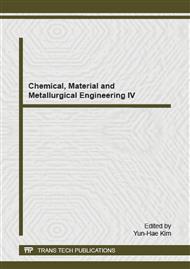[1]
Haibo Zhao, R.G. Tonkyn and S.E. Barlow: Ind. Eng. Chem. Res. Vol. 45 (2006), p.934.
Google Scholar
[2]
H. Tuovinen, P. Blomqvist and F. Saric: Fire Safety Journal Vol. 39 (2004), p.737.
Google Scholar
[3]
Min Jiang, Zhonghua Wang and Ping Ning: Journal of the Taiwan Institute of Chemical Engineers Vol. 45 (2014), p.901.
Google Scholar
[4]
Zhonghua Wang, Min Jiang and Ping Ning: Ind. Eng. Chem. Res. Vol. 50 (2011), p.12194.
Google Scholar
[5]
Shuai Yuan, Zhijie Zhou and Jun Li: Energy & Fuels Vol. 24 (2010), p.6166.
Google Scholar
[6]
Qinbin Li, D.J. Jacob and I. Bey: Geophys Res Lett Vol. 27 (2000), p.357.
Google Scholar
[7]
Hua Lu and Karlsson: Science of the Total Environment Vol. 334–335 (2004), p.125.
Google Scholar
[8]
P. Dagaut, P. Glarborg and M.U. Alzueta: Progress in Energy and Combustion Science Vol. 34 (2008), p.1.
Google Scholar
[9]
GB 16297-1996 Integrated emission standard of air pollutants [S].
Google Scholar
[10]
GB16171-2012 Emission Standard of Pollutants for Coking Chemical Industry [S].
Google Scholar
[11]
GB21900-2008 Discharge standard for pollutants from electroplating [S].
Google Scholar
[12]
Ping Ning, Ming Jiang and Xueqian Wang: Journal of Chemical Engineering of Chinese Universities Vol. 24 (2010), p.1038.
Google Scholar
[13]
Fengming Zhang, Kaixi Li and Chunxianng Lv: New Carbon Materials Vol. 18 (2003), p.151(In Chinese).
Google Scholar
[14]
Houzhang Tan, Xuebin Wang and Congling Wang: Energy & Fuels Vol. 23 (2009), p.1545.
Google Scholar
[15]
Haibo Zhao, R.G. Tonkyn and S.E. Barlow: Applied Catalysis B: Environmental Vol. 65 (2006), p.282.
Google Scholar
[16]
J. Giménez-López, A. Millera and R. Bilbao: Combustion and Flame Vol. 157 (2010), p.267.
Google Scholar
[17]
O. Kröcher and M. Elsener: Applied Catalysis B: Environmental Vol. 92 (2009), p.75.
Google Scholar
[18]
T. Nanba, A. Obuchi and S. Akaratiwa: Chemistry Letters Vol. 29 (2000), p.986.
Google Scholar
[19]
J.D.F. Marsh, W.B.S. Newling and J. Rich: Journal of Applied Chemistry Vol. 2 (1952), p.681.
Google Scholar
[20]
K. Rida, A. Benabbas and F. Bouremmad: Applied Catalysis A: General Vol. 327 (2007), p.173.
Google Scholar


